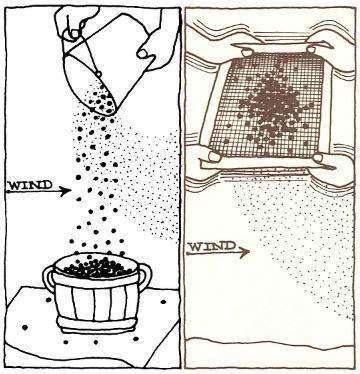It's easy to produce dry, mature shell beans for winter storage. In warm parts of the country, the beans and pods will mature and dry very well right in the garden. In the North, it's cool and sometimes wet in fall, so the beans often require additional drying. Pull up the plants and pile them around a fence post, roots to the post (like spokes in a wheel), to dry them some more. If you're having a wet fall, hang the plants from rafters in your garage or your attic. Anywhere that's airy and relatively dry will do. You can hang the plants themselves or put them in burlap or mesh bags. It's easy to tell when the beans are dry: They're so hard, biting into one won't even make a dent.
ThreshingThreshing by hand sounds like an old-fashioned chore, but it's simply the removal of the beans from the pods once the beans are dry. To thresh, take some of the plants by the roots - pods, beans and all - and whack them back and forth inside a clean trash can. The dry pods shatter, and the beans drop into the can. Toss the threshed plants aside and pick up the next bunch.
There are other ways to thresh beans, too. A fun method is to put the plants, again pods and all, in a big burlap or cloth bag. Then get a bunch of kids to walk and jump on the bag for a few minutes. Roll the bag over, and let them jump some more. Because the beans are dry and hard, the kids won't hurt them a bit. You can also let them have a good time hitting the bag with a baseball bat. Then open the bag, vigorously shake the plants to make sure all the beans are out of the pods, and remove the plants. You'll just have beans and small bits of debris, or chaff, in the bag. Alternately, you can cut off a small corner of the bag and let the beans drop out, leaving the plants inside.
Old-timers used to thresh beans with a homemade bean flail. The flail was made of two wooden sticks (one short, one long) hitched together at one end by a leather strap. They gripped the long stick and whirled the short one against a pile of dried bean plants laid out on a sheet of canvas on the floor of a barn. It was important to hold onto the long handle and use the shorter one to flail. The short stick couldn't whirl back and rap one's knuckles. After flailing awhile, you lifted the plants with a hay fork, shook them and then tossed them aside for the compost heap, leaving behind a pile of beans and chaff.
 Winnowing
WinnowingOnce you've threshed the beans, you need to separate out the chaff, and that's called winnowing.
On a windy day, take a basket of beans - chaff and all - and, holding it up high, pour the beans slowly into an empty basket on the ground. Repeat this a few times. The wind will blow all the chaff away as the beans fall. (It's a good idea to put a sheet under the basket on the ground to catch any beans that miss or bounce out.)
If you have a friend to help you winnow, spread the beans and chaff on a spare window screen outside on a windy day. When the two of you lightly jiggle and shake the frame, the chaff will blow away, leaving only the beans.
SortingThe final step before storing shell beans is sorting. It's important to remove the discolored, immature and misshapen beans from the good ones, because the bad ones could affect the taste.
An easy way to sort beans is to spread a white sheet over the kitchen table and pour the beans onto the sheet. The sheet makes it easy to roll the beans around, allowing you to check them carefully. Using this technique it's especially easy to spot bad white beans. Sorting is a chore, but if you enlist a friend to help, it can also be a time for a chat.
Dry beans will keep well in tightly capped, airtight containers, stored in a cool, dry, dark spot.
 Victory Seed Company has all the seeds you want for your best garden in 2024.
Victory Seed Company has all the seeds you want for your best garden in 2024.
For 25 years, the family-owned Victory Seed Company has provided the highest quality vegetable, herb and flower seeds to families across the country. We are passionate about providing you the best seeds available that give excellent germination, robust plants, and the harvest you want. With a catalog of over a thousand varieties, we have everything, and our prices are the kinds that we'd want to pay. We have hundreds of yesterday's heirloom vegetables, as well as today's award winning hybrid selections. Get to know us by visiting our website and browsing through our online vegetable seed catalog.
| 1. Picking Dried Shell Beans ← you're on this article right now |
| 2. Canning Beans |
| 3. Sprouting Beans |
| 1. Picking Dried Shell Beans ← you're on this article right now |
| 2. Canning Beans |
| 3. Sprouting Beans |